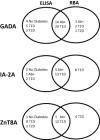Validation of a rapid type 1 diabetes autoantibody screening assay for community-based screening of organ donors to identify subjects at increased risk for the disease
- PMID: 27029857
- PMCID: PMC4908288
- DOI: 10.1111/cei.12797
Validation of a rapid type 1 diabetes autoantibody screening assay for community-based screening of organ donors to identify subjects at increased risk for the disease
Abstract
The Network for Pancreatic Organ donors with Diabetes (nPOD) programme was developed in response to an unmet research need for human pancreatic tissue obtained from individuals with type 1 diabetes mellitus and people at increased risk [i.e. autoantibody (AAb)-positive] for the disease. This necessitated the establishment of a type 1 diabetes-specific AAb screening platform for organ procurement organizations (OPOs). Assay protocols for commercially available enzyme-linked immunosorbent assays (elisas) determining AAb against glutamic acid decarboxylase (GADA), insulinoma-associated protein-2 (IA-2A) and zinc transporter-8 (ZnT8A) were modified to identify AAb-positive donors within strict time requirements associated with organ donation programmes. These rapid elisas were evaluated by the international islet AAb standardization programme (IASP) and used by OPO laboratories as an adjunct to routine serological tests evaluating donors for organ transplantation. The rapid elisas performed well in three IASPs (2011, 2013, 2015) with 98-100% specificity for all three assays, including sensitivities of 64-82% (GADA), 60-64% (IA-2A) and 62-68% (ZnT8A). Since 2009, nPOD has screened 4442 organ donors by rapid elisa; 250 (5·6%) were identified as positive for one AAb and 14 (0.3%) for multiple AAb with 20 of these cases received by nPOD for follow-up studies (14 GADA+, two IA-2A(+) , four multiple AAb-positive). Rapid screening for type 1 diabetes-associated AAb in organ donors is feasible, allowing for identification of non-diabetic, high-risk individuals and procurement of valuable tissues for natural history studies of this disease.
Keywords: autoantibodies; nPOD; organ donor; screening; type 1 diabetes.
© 2016 British Society for Immunology.
Figures




Similar articles
-
Characterization of human organ donors testing positive for type 1 diabetes-associated autoantibodies.Clin Exp Immunol. 2015 Dec;182(3):278-88. doi: 10.1111/cei.12698. Epub 2015 Oct 6. Clin Exp Immunol. 2015. PMID: 26313035 Free PMC article. Clinical Trial.
-
Screening for insulinoma antigen 2 and zinc transporter 8 autoantibodies: a cost-effective and age-independent strategy to identify rapid progressors to clinical onset among relatives of type 1 diabetic patients.Clin Exp Immunol. 2013 Jan;171(1):82-90. doi: 10.1111/j.1365-2249.2012.04675.x. Clin Exp Immunol. 2013. PMID: 23199327 Free PMC article.
-
A comparison of serum and EDTA plasma in the measurement of glutamic acid decarboxylase autoantibodies (GADA) and autoantibodies to islet antigen-2 (IA-2A) using the RSR radioimmunoassay (RIA) and enzyme linked immunosorbent assay (ELISA) kits.Clin Lab. 2008;54(7-8):227-35. Clin Lab. 2008. PMID: 18942490
-
Type 1 Diabetes-related Autoantibodies in Different Forms of Diabetes.Curr Diabetes Rev. 2019;15(3):199-204. doi: 10.2174/1573399814666180730105351. Curr Diabetes Rev. 2019. PMID: 30058495 Review.
-
T1D Autoantibodies: room for improvement?Curr Opin Endocrinol Diabetes Obes. 2017 Aug;24(4):285-291. doi: 10.1097/MED.0000000000000348. Curr Opin Endocrinol Diabetes Obes. 2017. PMID: 28509692 Free PMC article. Review.
Cited by
-
Pancreatic Histopathology of Human Monogenic Diabetes Due to Causal Variants in KCNJ11, HNF1A, GATA6, and LMNA.J Clin Endocrinol Metab. 2018 Jan 1;103(1):35-45. doi: 10.1210/jc.2017-01159. J Clin Endocrinol Metab. 2018. PMID: 28938416 Free PMC article.
-
Persistence of Pancreatic Insulin mRNA Expression and Proinsulin Protein in Type 1 Diabetes Pancreata.Cell Metab. 2017 Sep 5;26(3):568-575.e3. doi: 10.1016/j.cmet.2017.08.013. Cell Metab. 2017. PMID: 28877460 Free PMC article.
-
Monogenic Diabetes and Integrated Stress Response Genes Display Altered Gene Expression in Type 1 Diabetes.Diabetes. 2021 Aug;70(8):1885-1897. doi: 10.2337/db21-0070. Epub 2021 May 25. Diabetes. 2021. PMID: 34035041 Free PMC article.
-
Epidemiology of childhood-onset type 1 diabetes in Azerbaijan: Incidence, clinical features, biochemistry, and HLA-DRB1 status.Diabetes Res Clin Pract. 2018 Oct;144:252-259. doi: 10.1016/j.diabres.2018.09.009. Epub 2018 Sep 13. Diabetes Res Clin Pract. 2018. PMID: 30218742 Free PMC article.
-
Serum Trypsinogen Levels in Type 1 Diabetes.Diabetes Care. 2017 Apr;40(4):577-582. doi: 10.2337/dc16-1774. Epub 2017 Jan 23. Diabetes Care. 2017. PMID: 28115475 Free PMC article.
References
-
- Ziegler AG, Hummel M, Schenker M, Bonifacio E. Autoantibody appearance and risk for development of childhood diabetes in offspring of parents with type 1 diabetes: the 2‐year analysis of the German BABYDIAB Study. Diabetes 1999; 48:460–8. - PubMed
-
- Bingley PJ, Bonifacio E, Mueller PW. Diabetes Antibody Standardization Program: first assay proficiency evaluation. Diabetes 2003; 52:1128–36. - PubMed
-
- Lampasona V, Schlosser M, Mueller PW et al Diabetes antibody standardization program: first proficiency evaluation of assays for autoantibodies to zinc transporter 8. Clin Chem 2011; 57:1693–702. - PubMed
Publication types
MeSH terms
Substances
LinkOut - more resources
Full Text Sources
Other Literature Sources
Medical

